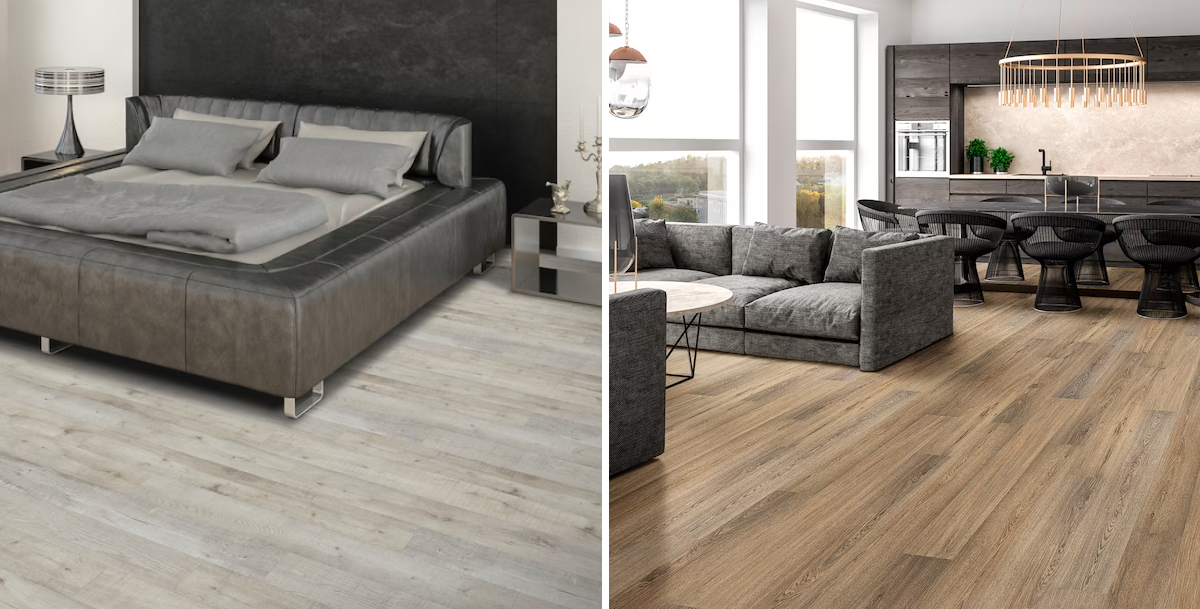
Laminate vs. Vinyl Flooring: Which Option Suits Your Home Best?
- My Store Admin
- 2025
Choosing the right flooring can feel overwhelming, especially when deciding between laminate and vinyl. Both are popular, durable, and visually appealing, but they have key differences that matter depending on your home, budget, and lifestyle.
This guide explains the main features of laminate and vinyl flooring so you can make an informed decision.
SHOP LAMINATE OR VINYL FLOORING NOW
What is Laminate Flooring?

Laminate was the first man-made alternative to natural wood. It is built from wood by products and has four layers:
-
Backing layer: Provides stability.
-
Core layer: Adds strength to the plank.
-
Design layer: Shows the look of wood, stone, or ceramic.
-
Wear layer: Protects the surface from scratches and daily wear.
Key Features:
-
Planks click together for a floating floor.
-
Solid surface with minimal movement underfoot.
-
Usually more affordable than many other flooring options.
What is Vinyl Flooring?

Vinyl is a synthetic flooring designed to resemble natural wood, stone, or ceramic. Luxury vinyl planks (LVP) are especially realistic and have three main layers:
-
Core layer: Solid vinyl for durability.
-
Design layer: Creates a natural appearance.
-
Wear layer: Shields against scratches and stains.
Key Features:
-
Can be installed as floating planks or glued-down sheets.
-
Soft underfoot for comfort.
-
Low maintenance and water-resistant.
Laminate vs Vinyl: How They Compare

Choosing between laminate and vinyl can be easier if you focus on the features that matter most to your home, lifestyle, and budget. Here’s a detailed look at the differences and advantages of each:
1. Appearance

Laminate flooring is designed with realistic embossing that closely mimics the textures of hardwood, stone, or ceramic tiles. Each plank has a design layer that gives it a natural and three-dimensional look. Vinyl flooring also looks very realistic, with a thick core that allows for deeper textures and intricate finishes. It can replicate wood grain, stone patterns, or even concrete surfaces very convincingly.
Key Takeaway: Laminate often looks closest to natural materials, making it a top choice if your priority is visual authenticity.
2. Durability & Water Resistance

Laminate is known for its durability, but it is sensitive to water. If moisture seeps into the core, it can cause swelling, warping, or even permanent damage. Scratches and dents on laminate are usually permanent, though minor ones can sometimes be repaired. Vinyl, however, is made from resilient polymer materials, making it waterproof and highly durable. It can handle spills, pet accidents, and even occasional standing water without damage.
Key Takeaway: Vinyl has the advantage when it comes to water resistance and long-term durability.
3. Installation

Laminate planks feature a click-and-lock system, which allows for quick and easy DIY installation. This floating floor method means you don’t need glue or nails, and it can often be installed over existing flooring. Vinyl planks can also use a click-lock method, but sheet vinyl generally requires professional installation. Sheets must be cut precisely and glued down, which can be challenging for beginners.
Key Takeaway: Plank-style laminate and vinyl are simple for DIY, while sheet vinyl is better left to professionals.
4. Lifespan & Warranty

Laminate flooring can last anywhere from 10 to 25 years if kept dry and maintained properly. Vinyl flooring also has a long lifespan, often up to 20 years, depending on the product quality and usage. Warranties vary but typically cover manufacturing defects and wear for many years.
Key Takeaway: Both flooring types offer comparable lifespans when cared for correctly.
5. Radiant Heat Compatibility

Radiant heating systems provide warmth through panels installed under floors or behind walls. Laminate conducts radiant heat effectively, making rooms cozy and evenly heated. Vinyl is also compatible with radiant heating, particularly when installed with self-leveling underlayment, which improves heat transfer.
Key Takeaway: Both laminate and vinyl work well with radiant heating, though laminate may slightly outperform vinyl in conductivity.
6. Pet-Friendliness

Laminate floors are fairly easy to clean, but water and pet accidents can cause long-term damage. Puppies, older dogs, or areas prone to spills may not be ideal for laminate. Vinyl is waterproof, easy to clean, and resistant to scratches, making it a more practical choice for pet owners.
Key Takeaway: Vinyl is generally more suitable for homes with pets, offering durability and low-maintenance care.
7. Cleaning & Maintenance

Laminate should be cleaned mostly with dry methods like a broom or dry mop. Damp mopping is only recommended for tougher stains. Deep scratches or water damage usually require individual plank replacement. Vinyl is easier to maintain—spills, dirt, and stains wipe away effortlessly, and damaged planks can often be swapped out individually.
Key Takeaway: Vinyl flooring is simpler to maintain and repair, which can save time and effort over the years.
Pros & Cons
Laminate Flooring
Pros:
-
Realistic wood and stone look
-
Scratch-resistant
-
Affordable
-
Low maintenance
-
Can be used with radiant heating
Cons:
-
Less water-resistant
-
Not ideal for bathrooms or basements
-
Louder underfoot
Vinyl Flooring
Pros:
-
Realistic appearance
-
Waterproof and durable
-
DIY-friendly installation
-
Easy to maintain
Cons:
-
May look synthetic in lower-quality products
-
Cheap vinyl can scratch or dent easily
Other Consideration
Both laminate and vinyl flooring are excellent, affordable alternatives to natural wood or stone. They are durable, attractive, and relatively easy to install.
When deciding, consider:
-
Your home’s design and décor
-
Family lifestyle, pets, and water exposure
-
Budget and maintenance preferences
Ready to choose your new flooring? The Secure flooring delivers directly to your home, making it simple to get the perfect floor for your space.
